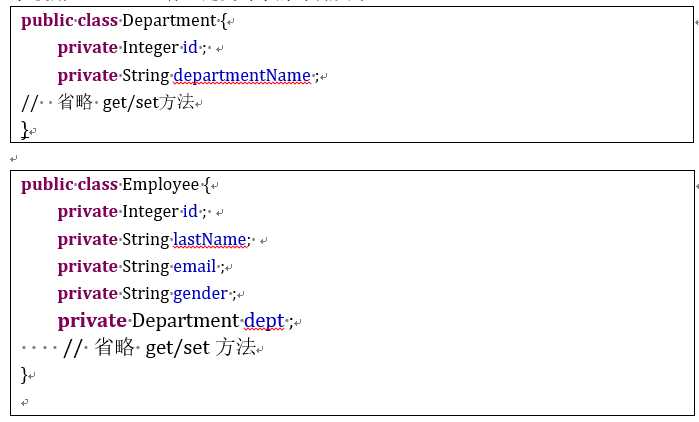resultMap自定义映射(多对一)
Posted lemonzhang
tags:
篇首语:本文由小常识网(cha138.com)小编为大家整理,主要介绍了resultMap自定义映射(多对一)相关的知识,希望对你有一定的参考价值。
自定义resultMap,处理复杂的表关系,实现高级结果集映射
1) id :用于完成主键值的映射
2) result :用于完成普通列的映射
3) association :一个复杂的类型关联;许多结果将包成这种类型
4) collection : 复杂类型的集
1、多对一的查询,员工与员工部门:
1)直接通过resultMap进行处理:
<!-- <resultMap>:自定义映射,处理复杂的表关系 <id column="eid" property="eid"/> <id>:设置主键的映射关系,column设置字段名,property设置属性名 <result column="ename" property="ename"/> <result>:设置非主键的映射关系,column设置字段名,property设置属性名 --> <resultMap type="Emp" id="empMap"> <id column="eid" property="eid"/> <result column="ename" property="ename"/> <result column="age" property="age"/> <result column="sex" property="sex"/> <result column="did" property="dept.did"/> <result column="dname" property="dept.dname"/> </resultMap> <!-- List<Emp> getAllEmp(); --> <select id="getAllEmp" resultMap="empMap"> select e.eid,e.ename,e.age,e.sex,e.did,d.dname from emp e left join dept d on e.did = d.did </select>
2)POJO中的属性可能会是一个对象,我们可以使用联合查询,并以级联属性的方式封装对象.使用association标签定义对象的封装规则

<resultMap type="Emp" id="empMap"> <id column="eid" property="eid"/> <result column="ename" property="ename"/> <result column="age" property="age"/> <result column="sex" property="sex"/> <association property="dept" javaType="Dept"> <id column="did" property="did"/> <result column="dname" property="dname"/> </association> </resultMap> <!-- List<Emp> getAllEmp(); --> <select id="getAllEmp" resultMap="empMap"> select e.eid,e.ename,e.age,e.sex,e.did,d.dname from emp e left join dept d on e.did = d.did </select>
3)association 分步查询
实际的开发中,对于每个实体类都应该有具体的增删改查方法,也就是DAO层, 因此对于查询员工信息并且将对应的部门信息也查询出来的需求,就可以通过分步的方式完成查询。
① 先通过员工的id查询员工信息
② 再通过查询出来的员工信息中的外键(部门id)查询对应的部门信息.
<!-- <resultMap>:自定义映射,处理复杂的表关系 --> <resultMap type="Emp" id="empMapStep"> <id column="eid" property="eid"/> <result column="ename" property="ename"/> <result column="age" property="age"/> <result column="sex" property="sex"/> <!-- select:分步查询的SQL的id,即接口的全限定名.方法名或namespace.SQL的id column:分步查询的条件,注意:此条件必须是从数据库查询过得 --> <association property="dept" select="com.atguigu.mapper.DeptMapper.getDeptByDid" column="did"/> </resultMap> <!-- Emp getEmpStep(String eid); --> <select id="getEmpStep" resultMap="empMapStep"> select eid,ename,age,sex,did from emp where eid = #{eid} </select>
<mapper namespace="com.atguigu.mapper.DeptMapper"> <!-- Dept getDeptByDid(String did); --> <select id="getDeptByDid" resultType="Dept"> select did,dname from dept where did = #{did} </select> </mapper>
③association 分步查询使用延迟加载:在分步查询的基础上,可以使用延迟加载来提升查询的效率,只需要在全局的Settings中进行如下的配置:
<settings> <!-- 开启延迟加载 --> <setting name="lazyLoadingEnabled" value="true"/> <!-- 是否查询所有数据 --> <setting name="aggressiveLazyLoading" value="false"/> </settings>
以上是关于resultMap自定义映射(多对一)的主要内容,如果未能解决你的问题,请参考以下文章